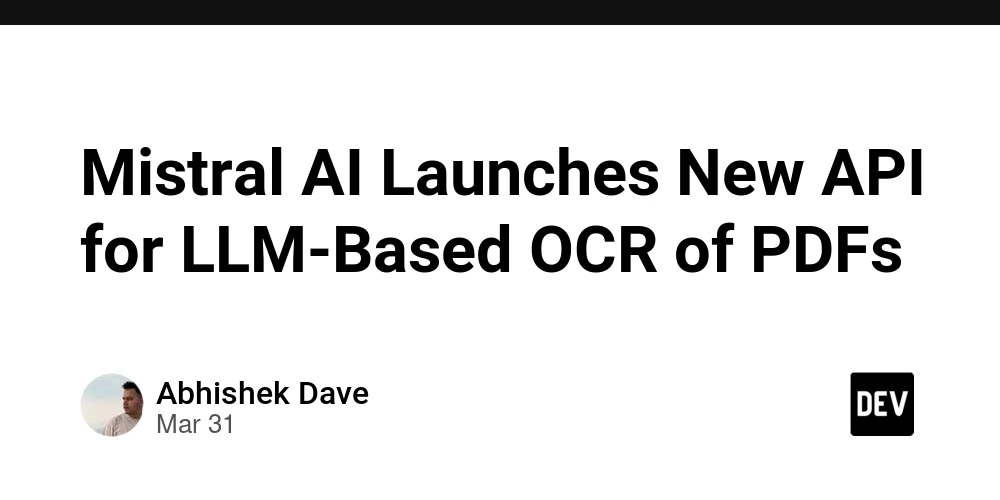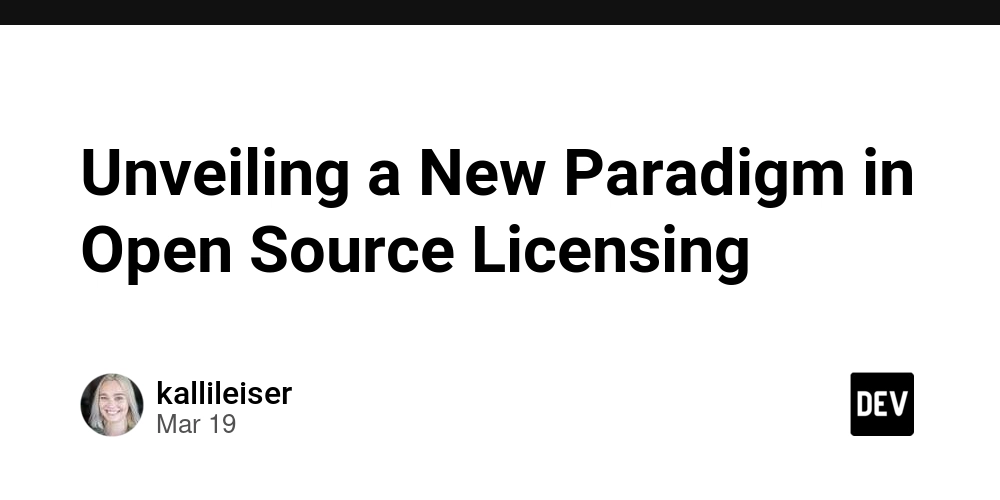Mistral AI Launches New API for LLM-Based OCR of PDFs
Originally published at ssojet Mistral AI has launched the Mistral OCR API, an advanced optical character recognition solution designed to digitize complex documents that contain interleaved text, images, tables, and mathematical expressions. Available on Mistral's la Plateforme SaaS, the API is particularly useful for sectors that handle scientific research, historical documents, and user manuals. /filters:no_upscale()/news/2025/03/mistral-ai-ocr-api/en/resources/1Screenshot 2025-03-31 at 10.33.34-1743417701375.jpg) According to Mistral, their OCR API outperforms major competitors like Google Document AI, Azure OCR, and GPT-4o, boasting unprecedented accuracy in understanding document elements. The API can process up to 2,000 pages per minute and handles embedded images alongside text, exporting results in Markdown, JSON, and other structured formats. Developers can integrate the API into workflows using Python through the mistralai package, which supports authentication and functionality access. The API currently supports documents up to 50MB or 1,000 pages, with pricing set at 1,000 pages per $1. Multilingual and Multimodal Capabilities Mistral OCR is designed to parse and transcribe a myriad of scripts, fonts, and languages, making it suitable for global organizations. The API excels in understanding complex document structures, including mathematical expressions and advanced layouts. The multilingual capabilities of Mistral OCR allow it to outperform other models in recognizing various languages, with accuracy rates reaching up to 99.54% across 11 languages. This makes it an essential tool for businesses that require document processing in diverse linguistic environments. Document Structure and Output Unlike traditional OCR solutions, Mistral OCR retains the hierarchical structure of documents, capturing headings, paragraphs, and tables. This structured data extraction is critical for enterprises that rely on data-driven insights and analytics. Mistral OCR's output is formatted in Markdown, which is beneficial for developers integrating this data into AI workflows. The API supports creating complex document structures, enabling users to pull specific data for further processing or integration into existing systems. Use Cases and Applications Mistral OCR is particularly beneficial for: Digitizing Scientific Research: Institutions are utilizing this API to convert research papers into AI-ready formats, enhancing collaboration and workflow speed. Preserving Historical Documents: Organizations are digitizing artifacts and documents to ensure their preservation and accessibility. Streamlining Customer Service: Customer service departments can leverage Mistral OCR to transform manuals into indexed knowledge bases, improving response times and customer satisfaction. Converting Technical Literature: It assists in transforming complex documents, such as engineering drawings and legal filings, into indexed, actionable formats. Competitive Advantage Mistral AI asserts that Mistral OCR is faster and more accurate than existing solutions, making it a viable option for organizations looking to enhance their document processing capabilities. The API's ability to integrate with large language models (LLMs) further positions it as a leading solution for enterprises that require sophisticated document understanding. Integration with SSOJet’s Services For companies looking to implement secure authentication methods alongside their document processing needs, SSOJet offers a robust API-first platform featuring single sign-on (SSO), multi-factor authentication (MFA), and Passkey integration. SSOJet's solutions include directory synchronization, SAML, OIDC, and magic link authentication, ensuring secure user management for enterprise clients. Explore how SSOJet can enhance your authentication strategies by visiting SSOJet. For personalized support or inquiries, contact us directly.

Originally published at ssojet
Mistral AI has launched the Mistral OCR API, an advanced optical character recognition solution designed to digitize complex documents that contain interleaved text, images, tables, and mathematical expressions. Available on Mistral's la Plateforme SaaS, the API is particularly useful for sectors that handle scientific research, historical documents, and user manuals.
/filters:no_upscale()/news/2025/03/mistral-ai-ocr-api/en/resources/1Screenshot 2025-03-31 at 10.33.34-1743417701375.jpg)
According to Mistral, their OCR API outperforms major competitors like Google Document AI, Azure OCR, and GPT-4o, boasting unprecedented accuracy in understanding document elements. The API can process up to 2,000 pages per minute and handles embedded images alongside text, exporting results in Markdown, JSON, and other structured formats.
Developers can integrate the API into workflows using Python through the mistralai package, which supports authentication and functionality access. The API currently supports documents up to 50MB or 1,000 pages, with pricing set at 1,000 pages per $1.
Multilingual and Multimodal Capabilities
Mistral OCR is designed to parse and transcribe a myriad of scripts, fonts, and languages, making it suitable for global organizations. The API excels in understanding complex document structures, including mathematical expressions and advanced layouts.
The multilingual capabilities of Mistral OCR allow it to outperform other models in recognizing various languages, with accuracy rates reaching up to 99.54% across 11 languages. This makes it an essential tool for businesses that require document processing in diverse linguistic environments.
Document Structure and Output
Unlike traditional OCR solutions, Mistral OCR retains the hierarchical structure of documents, capturing headings, paragraphs, and tables. This structured data extraction is critical for enterprises that rely on data-driven insights and analytics.
Mistral OCR's output is formatted in Markdown, which is beneficial for developers integrating this data into AI workflows. The API supports creating complex document structures, enabling users to pull specific data for further processing or integration into existing systems.
Use Cases and Applications
Mistral OCR is particularly beneficial for:
- Digitizing Scientific Research: Institutions are utilizing this API to convert research papers into AI-ready formats, enhancing collaboration and workflow speed.
- Preserving Historical Documents: Organizations are digitizing artifacts and documents to ensure their preservation and accessibility.
- Streamlining Customer Service: Customer service departments can leverage Mistral OCR to transform manuals into indexed knowledge bases, improving response times and customer satisfaction.
- Converting Technical Literature: It assists in transforming complex documents, such as engineering drawings and legal filings, into indexed, actionable formats.
Competitive Advantage
Mistral AI asserts that Mistral OCR is faster and more accurate than existing solutions, making it a viable option for organizations looking to enhance their document processing capabilities. The API's ability to integrate with large language models (LLMs) further positions it as a leading solution for enterprises that require sophisticated document understanding.
Integration with SSOJet’s Services
For companies looking to implement secure authentication methods alongside their document processing needs, SSOJet offers a robust API-first platform featuring single sign-on (SSO), multi-factor authentication (MFA), and Passkey integration. SSOJet's solutions include directory synchronization, SAML, OIDC, and magic link authentication, ensuring secure user management for enterprise clients.
Explore how SSOJet can enhance your authentication strategies by visiting SSOJet. For personalized support or inquiries, contact us directly.




















































%20Abstract%20Background%20112024%20SOURCE%20Amazon.jpg)






















































































































![[The AI Show Episode 142]: ChatGPT’s New Image Generator, Studio Ghibli Craze and Backlash, Gemini 2.5, OpenAI Academy, 4o Updates, Vibe Marketing & xAI Acquires X](https://www.marketingaiinstitute.com/hubfs/ep%20142%20cover.png)
























































































































































































































































-Nintendo-Switch-2-–-Overview-trailer-00-00-10.png?width=1920&height=1920&fit=bounds&quality=80&format=jpg&auto=webp#)





















_Anna_Berkut_Alamy.jpg?#)













































































































![YouTube Announces New Creation Tools for Shorts [Video]](https://www.iclarified.com/images/news/96923/96923/96923-640.jpg)





































































![[Weekly funding roundup March 29-April 4] Steady-state VC inflow pre-empts Trump tariff impact](https://images.yourstory.com/cs/2/220356402d6d11e9aa979329348d4c3e/WeeklyFundingRoundupNewLogo1-1739546168054.jpg)





























































